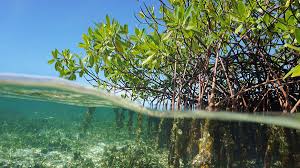GS 3 – ENVIRONMENT
Blue carbon ecosystems, encompassing mangroves, salt marshes, and seagrasses, are vital carbon sinks that significantly outperform traditional forests in carbon sequestration.

What Are Blue Carbon Ecosystems?
- Coastal and marine habitats that capture and store carbon.
- Crucial for biodiversity, marine life habitats, and coastal protection from erosion and flooding.
Carbon Sequestration Potential
- Mangroves sequester carbon at rates up to 10 times higher than tropical forests.
- Store over 1,000 tons of carbon per hectare.
- Restoring 10% of degraded mangroves could sequester 1.6 billion tons of carbon globally.
Economic and Environmental Benefits
- Boost local economies via sustainable fisheries and eco-tourism.
- In India, restored mangroves have driven government funding and increased coastal GDP.
- High ROI: Every dollar invested yields $6 in economic benefits.
Challenges in Conservation
- Threats: Agricultural expansion, coastal development, and illegal logging.
- Systemic delays in project execution.
- Lack of transparency in carbon credit markets reduces investor confidence.
Innovations in Restoration
- Global Initiatives:
- Australia’s Blue Carbon Method fosters investment in ecosystem restoration.
- AI mapping and blockchain improve monitoring and transparency.
- Community Projects:
- Successful mangrove restoration in Indonesia has improved local economies.
Future Outlook
- The blue carbon credit market is expected to reach $50 billion by 2030.
- Initiatives like India’s MISHTI (Mangrove Initiative for Shoreline Habitats and Tangible Incomes) highlight the growing commitment to restore mangroves and strengthen climate resilience.
Blue carbon ecosystems hold immense promise for mitigating climate change, protecting biodiversity, and fostering sustainable economic growth.




